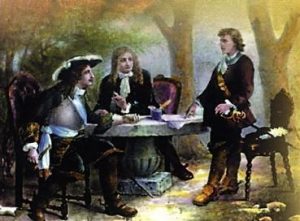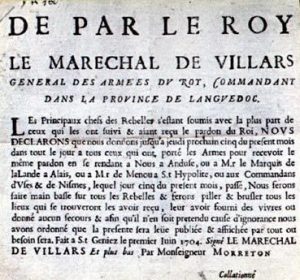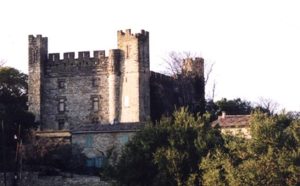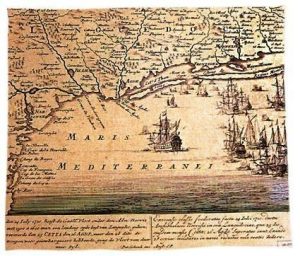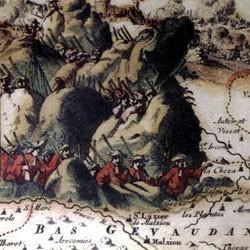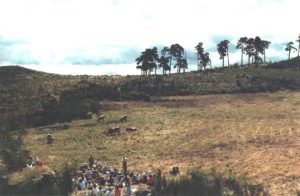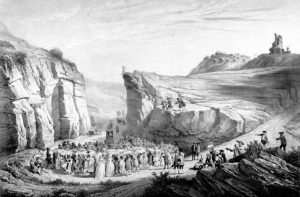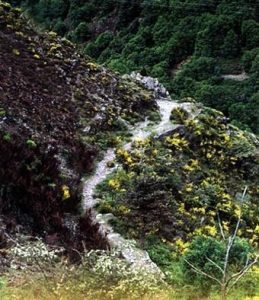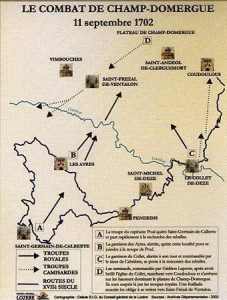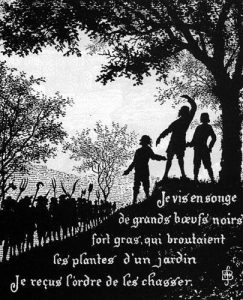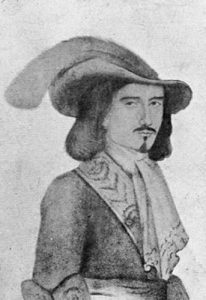Jean Cavalier's negotiation
After his great victory at Devois-de-Martignargues (near Vézenobre) on 15 March 1704, Jean Cavalier was severely defeated at Nages (near Nîmes) on 17 April 1704. A few days later the King’s troops discovered his secret storage of food and ammunition in caves at Euzet. This made him feel vulnerable as he knew it would be difficult to get food from the impoverished Cévennes population.
Cavalier accepted to negotiate with field marshal de Villars, who had arrived in Languedoc on 20 April to replace de Montrevel. De Villars proposed a truce to those who accepted to surrender. Cavalier first met two intermediaries, and then, on 16 May in Nîmes, he met with Villars and Basville, the administrator of Languedoc. Cavalier was more skilled on the battle field than he was at negotiating with important people. He accepted almost unconditional surrender.
The Calvisson truce (19-27 May 1704)
Cavalier’s surrender was sent to Versailles. Cavalier’s camisard troops were gathered in Calvisson (Gard) where they waited for the king’s answer.
For more than eight days they held numerous assemblies, preaching, praying and singing psalms. The neighbouring population flocked in. Field marshal de Villars did not interfere. They all believed freedom of thought and of religion would be restored.
The king’s answer finally arrived : the camisards were either allowed to go abroad, or else to sign up with the royal troops. But freedom of worship was not restored.
Cavalier was disappointed ; other camisard leaders were angry and, feeling betrayed, they let Cavalier down. On 21 June, Cavalier left the region with only a hundred men.
Rolland's death
During Cavalier’s negotiations, Rolland and his troops had set up a successful ambush at Plan-de-Fontmort in the Hautes-Cévennes. Rolland heard of Cavalier’s surrender and hesitated to do the same. As during the Spanish war of succession some foreign powers allied against king Louis XIV had promised some help, Rolland decided to keep fighting. But he was betrayed and on 1 August, 1704 was killed at the castle of Castelnau-les-Valence near Uzès.
The battle at Saint-Bénezet
On 13 September, 1704, Cavalier’s lieutenant was defeated at the Saint-Bénezet battle (south of Alès) and 100 to 200 camisards were killed. It was the last great battle of the camisards.
After the defeat that followed Roland’s death and under increasing pressure of the royal troops, camisard groups split up and progressively surrendered. Elie Marion, the camisard leader, and his friends were the last to sign their surrender in October. After a meeting with de Villars, Marion was exiled to Geneva and then to London. Most camisards went abroad. Some stayed, such as Abraham Mazel, stayed but the latter was arrested in January 1705 and imprisoned in the Tour de Constance at Aigues-Mortes. He escaped in July and left for Switzerland.
Foreign attempts
Powers allied against Louis XIV during the Spanish war of succession decided to support the Cévennes uprising as it was coming to an end late in June 1704. The Allies sent a fleet off the Languedoc shore but it was scattered by a storm.
In 1705 they tried to renew action and rallied some Catholics and noblemen of the Refuge movement, such as the marquis de Miremont. The aim was political rather than religious, claiming the restoration of the parliaments’ former prerogatives, and the abolition of taxes.
In the spring of 1705 a plot to kidnap Basville and the duke of Berwick – de Villars’ successor- failed. Basville had been warned and most plotters were arrested, notably Ravanel and Catinat who were executed.
In 1706 Cavalier, who was serving the duke of Savoy, headed a regiment that was to enter Languedoc through Catalonia. He was defeated at the battle of Almenza and his regiment annihilated, while he himself was severely wounded. He went to England and was eventually appointed governor of the Isle of Jersey.
Three years later, in June 1709, Abraham Mazel came back to France and attempted to lead an uprising in the Vivarais region. After a few successes, the camisards were defeated.
On 14 October, 1709, Abraham Mazel was betrayed and killed near Uzès.
In July 1710 the English landed in Bas-Languedoc and held the harbour of Sète for a few days.
From war to preaching
The last few camisards that remained in France were tracked down. Having abandoned all plans for eventual warfare, they wandered about in the Cévennes. Some, such as Jacques Bonbonnoux and Pierre Corteiz, became lay preachers and secretly gathered assemblies.
As from King Louis XIV’s death in 1715, they helped young Antoine Court to renovate Protestant Churches in France. The reforming movement of the Church began in the Cévennes where Pierre Corteiz was one of the first Desert pastors.

